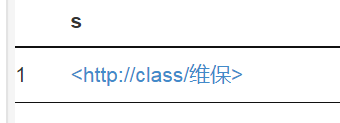SPARQL查询语句整理
本文大多内容来自Joshua Taylor的回答
https://stackoverflow.com/users/1281433/joshua-taylor
查询子类或等价关系
https://stackoverflow.com/questions/21092246/sparql-query-subclass-or-equivalentto/21093154#21093154
even though owl:equivalentClass is a symmetric property (i.e., from a owl:equivalentClass b we can infer b owl:equivalentClass a), the triple might be present in only one direction in the data
在数据里面等价关系是单向表示的,因此查询等价类的语句为
?myClass (owl:equivalentClass|^owl:equivalentClass)* :MyClass
查询等价属性的语句为
?p (owl:equivalentProperty|^ owl:equivalentProperty)* :order_no
查询<http://class/加工过程> class的property
SELECT ?subclass WHERE { ?subclass rdfs:domain <http://class/加工过程>.#加工过程类的所有属性 }

查询<http://class/加工过程>的所有属性的所有数据(s p o)
SELECT ?s ?subclass ?o WHERE { ?subclass rdfs:domain <http://class/加工过程>.#加工过程类的所有属性 ?s ?subclass ?o#返回属性关联的所有数据 } LIMIT 100

查询所有实例及其对应类型
SELECT ?instance ?s WHERE { ?instance rdf:type ?s. #找出实例的类型 }

查询值为1600KN20173的所有数据
SELECT ?instance ?p WHERE {
?instance ?p “1600KN20173”. #找出属性值为V101208的所有实例
}

如何获取实例对应本体
本体之间存在关系 Human ----(hasPizza)---> Pizzas
为本体添加实例 Human:Jim ----(hasPizza)---> Pizzas:cheesePizza
执行语句:
select ?x ?y where { ?x hasPizza ?y }
返回?x=Jim 和 ?y=cheesePizza
如何得到实例对应本体?
用turtle表示rdf
@prefix : <http://example.org/pizzas#> . @prefix rdfs: <http://www.w3.org/2000/01/rdf-schema#> . @prefix pizzas: <http://example.org/pizzas#> . @prefix owl: <http://www.w3.org/2002/07/owl#> . @prefix xsd: <http://www.w3.org/2001/XMLSchema#> . @prefix rdf: <http://www.w3.org/1999/02/22-rdf-syntax-ns#> . pizzas:Jim a pizzas:Human , owl:NamedIndividual ; pizzas:hasPizza pizzas:CheesePizza . pizzas:hasPizza a owl:ObjectProperty ; rdfs:domain pizzas:Human ; rdfs:range pizzas:Pizza . pizzas:Human a owl:Class . pizzas:Pizza a owl:Class . <http://example.org/pizzas> a owl:Ontology . pizzas:CheesePizza a pizzas:Pizza , owl:NamedIndividual .
可以看到在模型定义中,
pizzas:hasPizza a owl:ObjectProperty ; rdfs:domain pizzas:Human ; rdfs:range pizzas:Pizza .
因此可以利用属性hasPizza的rdfs:domain和rdfs:range两个关系来获得
查询语句为:
prefix : <http://example.org/pizzas#> prefix rdfs: <http://www.w3.org/2000/01/rdf-schema#> select ?domain ?range where { :hasPizza rdfs:domain ?domain ; rdfs:range ?range . }
返回:
------------------- | domain | range | =================== | :Human | :Pizza | -------------------
2.利用rdf:type获取
SELECT DISTINCT ?s WHERE { ?instance rdf:type ?s. #找出所有三元组的类型 }

返回了本体和实例数据的类型,混在一起了,因为本体和数据都是用三元组表示的
所以限定到具体数据,返回类型
SELECT DISTINCT ?s WHERE { ?instance ?p "三月". ?instance rdf:type ?s. #找出实例的类型 }
实例的rdf:
<rdf:RDF xmlns:rdf="http://www.w3.org/1999/02/22-rdf-syntax-ns#" xmlns:j.0="http://class/" xmlns:j.1="http://dataproperty/" xmlns:owl="http://www.w3.org/2002/07/owl#" xmlns:j.2="http://objectproperty/" xmlns:rdfs="http://www.w3.org/2000/01/rdf-schema#" xmlns:xsd="http://www.w3.org/2001/XMLSchema#"> <j.0:维保 rdf:about="http://individual/维保/1600KN20173"> <j.1:保养人>empty</j.1:保养人> <j.1:实际保养日期>empty</j.1:实际保养日期> <j.1:所需工时_人数_时间>2*0.1</j.1:所需工时_人数_时间> <j.1:计划保养时间>3月5日——3月11日</j.1:计划保养时间> <j.1:计划保养周>第10周</j.1:计划保养周> <j.1:设备保养级别>1级</j.1:设备保养级别> <j.1:月份>三月</j.1:月份> <j.1:维保计划编号>1600KN20173</j.1:维保计划编号> </j.0:维保>
查询结果:

上述查询语句是对整个数据库进行查询,所以查询了所有路径下的数据:
"http://class/"
"http://dataproperty/"
"http://objectproperty/"
等等
可以指定PREFIX : <http://class/> 减小查询范围
比如下面语句
就指定了在‘:’的范围中查找等价属性
PREFIX : <http://www.siemens.com/semantic_web#> PREFIX owl: <http://www.w3.org/2002/07/owl#> SELECT ?property WHERE { ? property (owl:equivalentProperty|^owl:equivalentProperty)* :order_id. }





